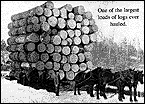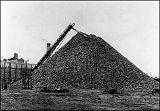In order to cope with the shift from lumbering, business leaders adapted operating structures and exploited the new mix of dominant trees. Aspen and birch made poor lumber, but they pulped well. In the first decades of the twentieth century, paper mills were built along the Mississippi, Rainy and St. Louis Rivers.
The way loggers harvested the northeastern- Minnesota forests also changed dramatically. Horses were gradually replaced by small tractors. Chain saws became the common tool for felling trees. Tractor-like skidders were used to drag whole trees to roadside lots where they were loaded on trucks for hauling to mills. By the 1970s, the conversion to mechanized harvesting had been completed.
[MIACOC & WFMFED] |
|
|
Lumberjacks

One of the largest loads of logs ever hauled.
Engraving from Harper’s Weekly, ca. 1890s

Pulpwood storage pile at Minnesota and Ontario Paper Company,
International Falls, ca. 1925
U.S. Forest Service and Minnesota Historical Society
|





